|
|
Foreplay
In 2004 I reviewed the then-new flagship
models of the Marantz line in these pages and noted in passing that they
might raise the bar of performance and improve the bang for the buck
ratio for all the large audio firms. It seemed the off-shore
mass-production techniques employed in the large production runs of
major manufacturers (such as Marantz) had been closing in on the
superiority previously enjoyed by the smaller boutique companies with
their small production runs. ("Little bugs have littler bugs/on their
backs to bite 'em./And littler bugs have littler bugs,/ and so on
infinitum." Jerry Garcia.) [Not to mention Jonathan Swift …not
one of the Grateful Dead, I might add. - Ye Olde Editor] For
years it has been a not so tightly held secret that many "High-End"
lines have their designs assembled in certain mainland Chinese or
Taiwanese factories, where, whether the product is made with tubes,
transistors, or nuvistors, small production runs allow for greater
quality control.
I wondered how long it would take for the
trickle-down of improved technology in large scale production to make
such quality available at much reduced prices. These two new products
(the made-in-Japan Marantz SA-11S1, and the PM-11S1) seem to be the
first of the new wave, employing many features used in their flagship
models, but at lower cost. I really hate to be an "I told you so,"
you'll notice. Whereas the absolute top-of-the-line Marantz Reference
Series SACD player, preamp, plus two monoblocks together list for nearly
$31,000; the two newer pieces of their next-to-top-of-the-line (CD
player and integrated amp), together list for about $8,000. At around
25% the cost, can the two pieces deliver the same functions? I think so,
albeit with 100-wpcinstead of 300 (which is only 4dB, or so, louder).
The same quality? I think so; perhaps better than the earlier
gear, with their second generation HDAM®s. How do they stack up
to the competition at that price point? I'll have to leave it to you to
survey the field; well, if not the entire field, only the competitive
pieces you're interested in. I can only say, distinctions between High
End and alleged Mid-Fi just got a lot more complicated.
HDAM®
"What is the HDAM®?" you might ask. A good
question, since at around the same time, some other pretty highly
respected manufacturers began using them. I think HDAM® stands for "High
Definition Amplification Module," which doesn't explain much. Just to
rev the suspense up a notch, Mark Levinson and Musical Fidelity are
using HDAM® type circuits as well, though they might call them something
else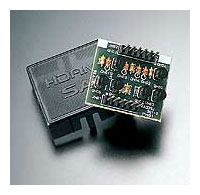 because the registered term "HDAM®" was first used by Marantz, and each
of those other firms likely has engineered its own variation on the
circuit they use. Or, it may be an unsubstantiated rumor. Marantz claims
to have invented the HDAM® and copyrighted the term in 1992. Levinson
seems to have used buffer circuits in their Preamp #32 released in 1999,
calling them "high performance buffer amplifiers." Musical Fidelity
released its Nu-Vista pr-amp in 1998, and has had its stand-alone Model
X-10v3 Tube Output Buffer amp on the market for nearly as long. At least
in this one example, two relatively small "High-End" Boutique firms may
be competing with a "Mid-Fi" mass-production giant for the recognition
of having first introduced the discrete-parts operational-amplifier to
the Hi-End.
because the registered term "HDAM®" was first used by Marantz, and each
of those other firms likely has engineered its own variation on the
circuit they use. Or, it may be an unsubstantiated rumor. Marantz claims
to have invented the HDAM® and copyrighted the term in 1992. Levinson
seems to have used buffer circuits in their Preamp #32 released in 1999,
calling them "high performance buffer amplifiers." Musical Fidelity
released its Nu-Vista pr-amp in 1998, and has had its stand-alone Model
X-10v3 Tube Output Buffer amp on the market for nearly as long. At least
in this one example, two relatively small "High-End" Boutique firms may
be competing with a "Mid-Fi" mass-production giant for the recognition
of having first introduced the discrete-parts operational-amplifier to
the Hi-End.
All I have are the following facts,
communicated by Mr. Kevin Zarow, Vice President of Marketing for Marantz,
in an email dated 12/04/2006. In September of 1992, or fourteen years
ago, in Japan, Marantz released an integrated amplifier, the PM-99SE,
that used HDAM®s extensively. The term "HDAM®" was registered by the
Marantz Corporation a little in advance, or at about the same time. The
piece, PM-99SE, was never marketed in the United States, although
Marantz used HDAM®s in many products since the mid-90s—especially on CD
players (CD-63-SE for just one example). That's the best information I
can get.
According to a technician in the customer
service side of the Mark Levinson office, they didn't begin using their
"high performance buffer amplifier" until the debut of their
Preamplifier #32, which was released toward the end of 1999 or the
beginning of 2000, I'm told. It would be jumping to conclusions to say
the Mark Levinson engineers were mimicking the Marantz guys' latest
wrinkle in op-amps. They might have come at the problem from different
directions (like Descartes and Leibniz did in "inventing" calculus), and
solved it simultaneously. Might have. That's an opinion.
At their website Musical Fidelity says they
introduced a pr-amp called the Nu-Vista pr-amp in 1998, and their Nu-Vista
Power Amp in 1999. These pieces used nu-vistors, highly miniaturized
vacuum tubes in metal (not glass) jackets. They also developed their
Model X-10v3, a stand-alone Output Buffer amplifier, at about the same
time. Their website claimed their buffer amp was essentially the same as
the output of their top-of-the-line CD player, and it could transform a
modestly-priced CD player into a first class piece. That's their
opinion. It really doesn't matter who came first, but it would be ironic
if the high-tech high-end firms were following the lead of the mid-fi
engineers. And that's my opinion.
Plasma?
So, again, exactly what is an HDAM®?
Essentially an HDAM® is an operational amplifier built of discrete parts
(as opposed to "surface mounted parts" in an 8-pin DIP, IC package).
Op-amps are used all over solid state circuits, and there are some
designed as an IC 8-pin DIP (Dual In-line Pins) chip that sound really
fine. When selected for audio use, as the result of exhaustive listening
tests, the process is somewhat random because most chips are designed
for use in computers, TV, telephone, or micro-wave circuits—that is, for
use in applications that go beyond the audio frequency band, and some
just happen to sound good. Hear the Grado RA-1 and the Ray Samuels
Emmeline Hornet for two examples. Aye, 'tis true some better IC op-amps
have found welcome use in buffer circuits. Aye, but—aye but,
there are some things about the usual 8-pin DIP op-amp chip that can get
it in trouble no matter how sophisticated the circuit topology, or how
thoughtful the designer is in using it.
These trouble makers are: poor conductivity
due to badly engineered traces in the chip, heat developing
within the chip, electronic and magnetic interference (the parts
talk to each other), "plasmas and plasma-surface interactions,"
["plasma: a collection of charged particles ...containing about equal
numbers of positive ions and electrons and exhibiting some properties of
a gas but differing from a gas in being a good conductor of electricity
and in being affected by magnetic field." Webster's 9th
Edition] that is, small magnetic field interactions, etc.
Each can cause the IC op-amp to misbehave, and together cause
heaven-only- knows-what plasmatic havoc. [For more detail, see
"Integrated Circuit" in Wikipedia on-line.] Critics of ICs hold that all
ICs have problems with Quality Control, their small size creates design
limitations, and they are never (well, hardly ever) designed to optimize
their performance in audio applications. Custom, audio-appropriate,
discrete-part op-amps could be designed to overcome those problems
inherent in IC op-amps, and (I assume) the manufacturers named above
have taken it upon themselves to do just that. Somewhere (was it
http://www.bursonaudio.com?) I read that, so far, such op-amps are
mostly found on pieces of gear in the above $3,000 category. That may no
longer be up to date.
The reason I'm giving you so much
information about HDAM®s (all of which is available on-line) is that I
think this kind of incremental (as opposed to radically different)
breakthrough is one that brings about a subtle, but real wave of
improvement in sound (as opposed to a Tsunami). Marantz claims it was
first to use HDAM®s in 1992, and used eight of their proprietary design
HDAM®s in the Model SC 7 preamp, and four more in the MA 9 amp that
debuted more than three years ago in the U.S. (and two years before that
in Japan). About the same time Mark Levinson and Musical Fidelity began
using discrete-part op-amps of their own design, three other firms whose
names and reputations are not known to me (Greek, Aqvox, and Sphix)
started using them as buffer amps. Burson Audio of Melbourne, Australia
has sent me for review a stand-alone buffer circuit that uses discrete
op-amps (in voltage-differential topology), which has enthralled me in
its first listening sessions. It is also a piece in-queue for
full-review and I have high hopes for it. My point here is that the word
is out, and it won't surprise me if more (hand or robot assembled)
audio-appropriate, discrete-part op-amps start making it into the better
solid-state gear.
[By the way, did you notice that I gave
the audio side of the Marantz DV660 "universal" CD player very high
marks in its review some months back? That when I looked inside I
noticed the audio-out line-amp was made of discrete parts, and that they
were spaced relatively far apart from each other (a semi-HDAM®)?
Certainly farther than on an IC chip! This was not a hand-built circuit,
but it sounded better than many SACD players I've heard lately,
especially at the $600 price-point; and the unit plays DVDs and
surround-sound, too. I think this is how technological improvements
spread, through word-of-mouth in the designer (and consumer) community.
Max]
What is an HDAM® then, and why ought we to
pay attention to it? It is a discrete-parts operational-amplifier, one
that can employ various devices (transistors or nuvistors), and various
configurations including the pretty sophisticated voltage-differential
set up; and it might be used in various ways; as a buffer stage (or
impedance-matching device) on each and every input and output of a
preamp, as on the Marantz PM-11S1 integrated. According to the Mark
Levinson website, their best pr-amp #32 uses their "high performance
buffer amplifier" in a similar fashion. Such an op-amp also can be
useful after most analog output stages, as an output stage and/or a
stand-alone output buffer itself (as do the Musical Fidelity and the
Burson), or as a driver stage before the output stage of a power
amplifier (as does Marantz in its MA9 and PM-11S1).
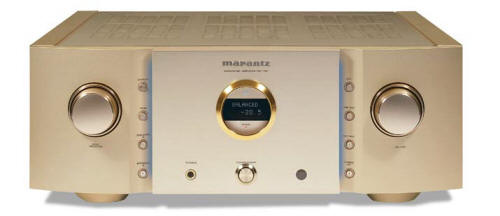
A well designed version of a discrete parts
op-amp, by introducing a friendlier impedance match, would lessen noise
and distortion, lower output capacitance, handle high current when
necessary, manage broad bandwidth, and increase dynamic range, as the
Levinson website suggests. Critics seem to agree that such well executed
op-amps improve the sound in real, if subtle, ways, like the difference
between real good perfume and human pheromones. I'd guess they'll be all
over the better gear in the next few years, because they are very
effective, although other (less expensive) variants might break through
into the mid-fi, if the Marantz DV660 universal player is any example.
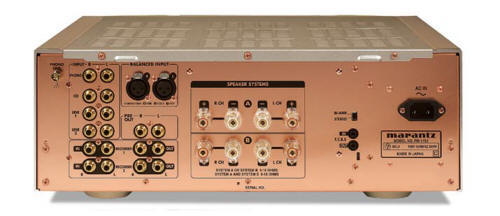
The Sound
How do these two Marantz pieces (the
integrated amp and the SACD player) sound? Where, exactly, is the HDAM®
improvement? The sound is very refined, unspectacularly natural. Subtle.
There is a lack of "Hi-Fi Sound." The overall effect is the opposite
of IN YOUR FACE: maybe "diffident" is the right word.
Addition-by-subtraction is more complex, a harder to hear shift in
perspective than bigger, more powerful, MORE. Marantz bass, for example,
is excellent and it has the desirable trait that as the volume increases
the bass does not ring. That seems to say the amp has a high damping
factor (not included in the Marantz spec sheet), which may not be the
exact explanation of why the amp doesn't ring. It might be the
friendlier impedance match between the HDAM® driver stage and the output
stage of the amp. I'm only hypothesizing here. I would like to see a
damping factor spec and an explanation from the Marantz folk. But if my
hypothesis is correct, we might see a stampede of me-too designs.

The SACD/CD player also shows pretty
terrific bass cohesiveness (attack, sustain, decay ratios; similar
freedom from overshoot) when auditioned through headphones. For example,
Mark Summer's cello solo "Kalimba"on Paquito D'Rivera's CD, The Jazz
Chamber Trio (Chesky; JD 293), is among the most complex to play,
record, and reproduce through a sound system—and get right—that I've run
across. When I played the two Marantz pieces through my Lowther PM5A
systems, through Ecosse interconnects and speaker cables (also, in the
queue for review), I had to add 6dB of bass (to compensate for the well
known Lowther bass-shyness) through the bass control on the preamp
section of the PM-11S1. While one might expect some ringing in that
situation, I could hear none; no smearing, masking, or overshoot etc.
Nada. The bass got fuller and louder, and I felt I'd been moved a bit
closer, but the bass never sounded tubby, wooly, or boomy. Only very
well designed gear, pieces with multi-segmented and multi-regulated
power supplies, (and with HDAM®s in strategic places)—which the Marantz
integrated amp has—behave like that in my experience. The same is true
for high-frequency splash or overshoot: there is none that I could hear,
no matter how loudly I played it.
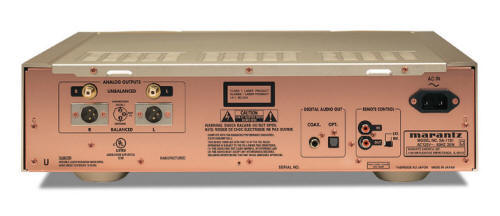
The mid-range follows the pattern of
emphasis on natural sounding sound, rather than attention-grabbing,
realer-than-real "hi-fi" effects. My Lowthers' presence peaks seemed at
least considerably tamed by the Marantz gear. The effect gave me the
most convincing illusion of a position in the symphony hall farther back
than any other amp I'd ever auditioned with my frontal Lowthers in my
listening room. The CD player/amp combination is notably ring-free in
reproducing female voice. It can minimize the "metallic" coloration some
sopranos exhibit in performance, and eliminate it when it is not there
in the first place. This is especially evident with excellent
recordings, such as the singing of Woojung Kim on David Chesky's "The
Girl From Guatemala" on his Area 31 album, (Chesky, SACD 288).
Performing the vocal acrobatics you'd expect of a modern concert piece,
Kim never sounds nasal, metallic, or shrill. It is amazing to hear music
without such colorations when for years I believed they were just
inherent in the recording and reproduction process, something I could do
nothing about.
[Art Dudley implies the same resignation
about LP reproduction before hearing The Well Tempered Record Player,
(in Stereophile, Nov. 2006, p. 42), where he writes, "... the resonant
energy created during record playback is itself a cause of
distortion..." To avoid charges that I quote him out of context, I
should add he then goes on to tell how the Well Tempered engineers
minimize that distortion. Max]
The Art of "Less is More":
Other excellent pieces of gear add some of
those colorations to the soprano voice (in particular) at full cry, but
they are so good at other things we tend to forgive them a minor glitch,
or we listen to such selections at slightly lower levels and blame the
shrillness on the recording engineer. Listening through the Marantz CD
player and integrated amp, and my Lowthers, I heard some of the cleanest
sound I've heard outside of a performance venue, though I can only
characterize it as having less of the usual pitfalls; masking, boom,
tizz, overmuch presence. Sometimes, less is more. Definitely.
But, what are we dealing with here? Seems
like small increments of improvement at the edges of perception: freedom
from masking, freedom from boom and tizz, freedom from many annoying
(chalk on blackboard type) colorations, freedom from up-front sonic
obtrusiveness (by moving the listener farther back in the listening
hall). These are not giant steps, but they do add up. These are subtle
small steps, like a prima ballerina's pitty-patting herself into
position to perform some of the most wonderfully expressive of human
movements that are the emotional highlights of ballet. This less
expensive, second from the-top-of-the-line, Marantz front-end delivers
equally well the big emotional moments of music under complete control,
down to the smallest detail. If these small increments of improvement
get the details right, they quite rightly suggest the gear will
reproduce most everything else gracefully and with ease. So if
"diffident" is a word that describes this gear, so do the words
"graceful" and "relaxed." Sometimes a handful of such small refinements
synergistically make all the difference in the world.
And if all these improvements (minimizing
distortion, maximizing dynamics, for two), or "refinements," if you will
allow me, that separate the great from the merely very good, or the
merely excellent, are important to you, then you must consider these two
pieces as candidates for your system. In certain circles some
audiophiles are willing to pay $10K for a phono cartridge to capture the
smallest of LP detail, or $30,000 for a power amplifier that delivers an
agreeable facsimile of BIG, in-the-Symphony-Hall sound. These pieces of
Marantz gear, having such outstanding sonic performance, are an exciting
team, in terms of price/performance ratio, or in terms of excellence for
its own sake. These second from the top-of-the-line pieces approach the
performance of the Levinson and the Mobile Fidelity. And they are way
less expensive. Hey, sometimes less is more. But each according to his
taste.
Sometimes More is More
Some folks like music gritty and raw. And
this kind of gear might not give the kind of facsimile they would expect
from a get-down blues-band recording, though it might be more natural.
Yet for lovers of big classical music, chamber music, jazz, show tunes,
opera, folk music, even bluegrass, café singers, unaccompanied vocal
groups, this is the kind of electronic gear that will capture all the
nuances you're looking for; the size of the room, the placement of the
instruments, the subtleties of performance, all with a natural sounding
ambiance that eliminates the realer than real, electro-mechanical
presentation we've come to call, "the hi-fi sound," or "more is more."
And it is this realistic balance that may be at the heart of the "less
is more" style this gear offers. If you like "More is More," you might
like a rock PA system in your listening room. There is no accounting for
taste.
The Usual Suspects
To what does the listener owe a tip of the
hat? There are so many production features in the two pieces it would
take a very long list to name them. For example, both pieces enjoy the
presence of over-sized toroidal transformers that like to devour hum.
Similarly they each benefit from a heavy copper-plated chassis, with a
double bottom, that mechanically damps unwanted air-born acoustical
vibrations from the music that cause acoustical feedback, and physical
insults like foot-falls that amplified through a system sound like
rolling thunder; while the copper plating electronically shields the
circuits from nasty radio frequency interference (such as taxi-cab
radios) and electromagnetic radiation (such as household computers and
appliances) that it bleeds to ground.
The SA-11S1 SACD/CD player also enjoys a new
and improved precision laser mechanism with a "stabilizer plate." There
are accurate and selectable digital filters that can make red-book CDs
sound very much like SACDs. At first I thought I'd never use them, but
they do behave as advertised. Each channel of the output stage enjoys
triple HDAM® circuitry, as I might have mentioned earlier. They also
benefit from a Phase Error Correction (PEC) circuits that virtually
eliminate Phase Delay. And the LCD display unit is handled in a way that
produces Zero Noise.
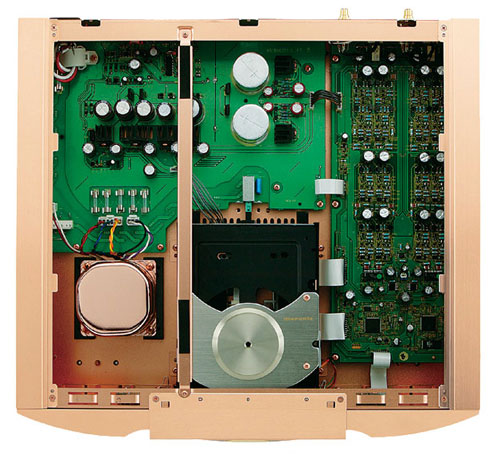
The PM-11S1 integrated amp employs many of
the best design elements of the Separate SC-7S1 (Preamp) and the MA-9S1
(Monoblock Amp). It has an expensive "Hybrid" Toroidal Transformer,
somewhat tweaked from the original, that is the center of its
multi-segmented power supply system. It employs an expensive choke input
system power supply circuit that kills the hash that rides on the "white
noise" of a merely capacitor filtered power supply. It employs a new and
expensive HDAM®, designated as HDAM-SA2®, in its output circuitry. All
inputs and outputs, including phono, are buffered with more expensive
HDAM-SA2® modules. The integrated amplifier offers a floating control
bus system that can link it with one or two more PM-11S1 units for
Multi-Channel configuration. The volume control is of the high precision
type, and the speaker terminals are from WBT. These are visible
expenses. Inside there is a similar array of premium parts that remain
otherwise invisible. And, did I mention? the LCD display unit is handled
in a way that produces zero noise. For more specifications go to the
Marantz website
http://us.marantz.com/products/630.asp. The information in the spec
sheets isn't the best, but it is adequate. There is a lot of advanced
engineering stuffed into these two pieces.
Summing Up
Did I remember to say at the outset, this
gear is pretty terrific as far as fit and finish is concerned? Its style
and look is equally impressive as its use of op-amps as buffer circuits.
These newer 2nd generation HDAM®s are pretty slick, as is the
multi-segmented and regulated power supply. Together these two pieces
produce a very understated, beautiful sound. If I were as foolish as I
was in 2004, when I reviewed the Marantz top-of-the-line separates, I'd
call the sound "retro," and praise it for sounding much like the sound
of the golden era of tubes. Today I recognize the sound is much in
advance of the "golden oldies." The sound is warm, dynamic, free of
colorations, and the like, but it is also (in software and hardware) far
ahead of the sounds that were available back then, and what was
available even to recording engineers. I'd go on to say, the sound
available through the Marantz SA-11S1 SA-CD player, with the PM-11S1
integrated amp is better than anything Saul Marantz and Sid Smith (his
chief engineer) ever got to hear in their homes. I think they'd be
jealous, but proud. "Well done!" they'd say to the Marantz engineering
guys. If you can't imagine that, then I'll say it: "Well done!" I'll
leave it to wiser heads than mine to judge whether this Marantz gear is
high-end or mid-fi.
Either way, when you put on your Top Hat and
Tails to show off your best gal, your best pal, at your Marantz dealer,
and she's lookin' good enough to get their attention, do a little Fred &
Ginger over to the showcase, and when she demurely places her
Platinum Card on the counter, remember to have her tell 'em, pouting
suggestively as good taste allows, Max Dudious sent 'ya.
Ciao, bambini.
Marantz SA-11S1 Reference Series SACD/CD
player
Retail: $3499.99
Marantz PM-11S1 Reference Series
Integrated Amplifier
Retail: $4399.99
Marantz
web address:
http://us.marantz.com
|
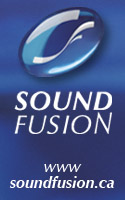


 because the registered term "HDAM®" was first used by Marantz, and each
of those other firms likely has engineered its own variation on the
circuit they use. Or, it may be an unsubstantiated rumor. Marantz claims
to have invented the HDAM® and copyrighted the term in 1992. Levinson
seems to have used buffer circuits in their Preamp #32 released in 1999,
calling them "high performance buffer amplifiers." Musical Fidelity
released its Nu-Vista pr-amp in 1998, and has had its stand-alone Model
X-10v3 Tube Output Buffer amp on the market for nearly as long. At least
in this one example, two relatively small "High-End" Boutique firms may
be competing with a "Mid-Fi" mass-production giant for the recognition
of having first introduced the discrete-parts operational-amplifier to
the Hi-End.
because the registered term "HDAM®" was first used by Marantz, and each
of those other firms likely has engineered its own variation on the
circuit they use. Or, it may be an unsubstantiated rumor. Marantz claims
to have invented the HDAM® and copyrighted the term in 1992. Levinson
seems to have used buffer circuits in their Preamp #32 released in 1999,
calling them "high performance buffer amplifiers." Musical Fidelity
released its Nu-Vista pr-amp in 1998, and has had its stand-alone Model
X-10v3 Tube Output Buffer amp on the market for nearly as long. At least
in this one example, two relatively small "High-End" Boutique firms may
be competing with a "Mid-Fi" mass-production giant for the recognition
of having first introduced the discrete-parts operational-amplifier to
the Hi-End. 



